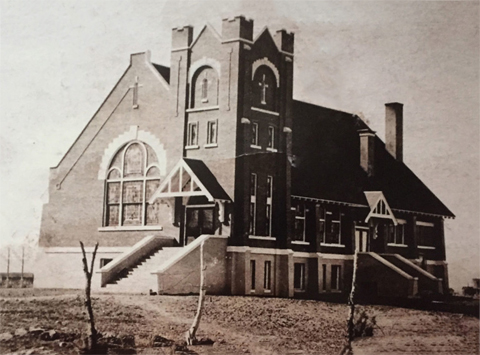Before Idaho became a territory in 1863 and before Oneida County was formed in 1864, there were people moving into the Malad Valley.
After members of the Church of Jesus Christ of Latter-day Saints settled in the Salt Lake City area in 1847, colonists started moving into other areas in the Great Basin. Many groups were searching for pasture for their livestock. Brigham Young, the President of the Church at that time, began a concerted effort to expand the settlement of the members of his church. In the early 1850’s, settlements were developed in other parts of Utah.
President Brigham Young came to southern Idaho in June of 1855, where he reported good grass and wheat lands in the Bear River and Malad Valleys.
As reported by Glade Howell in his thesis entitled “Early History of Malad Valley” written for the Department of History, Brigham Young University, he told of a second trip to the Malad Valley in 1857 by President Young when he wrote, “Malad Valley north of Bear River, has been considered a pretty desolate, cold, hard, sterile valley. It was so looked upon by us, as we passed through it on our way north. At the same time we considered it a tolerably good grazing country, and that people could possibly live there. But after we had traveled over the basin rim into Bannock Valley, descending a mountain beside the one we called Big Mountain is a mole hill, down through the little Bannock Valley on to Shanghi Plain and traveled northeasterly and northwesterly almost in a semicircle to Spring Creek, then up Spring Creek over to Salmon River and wended our way down that stream through the swamps and willows and climbed over the points of the bluffs to keep from being mired, and had paid our brethren a visit and returned again to Malad Valley, it looked to us like one of the most beautiful valleys that any person had ever beheld, while before this experience we thought nobody could live there and I expect that if we had gone a few hundred miles north, it would have looked still better.”
In 1855, fifteen families led by Ezra Barnard, settled on the east side of the Malad River on the south end of the Malad Valley, which was called Oregon Springs. Again quoting Howell, he said that some of the other settlers were, “Daniel and James Stewart, A. B. Hill and James Frodsham. Emmeline Waldron and Amelia Frodsham were the only women in the first party. Emmeline Eliza Waldron, the daughter of Emmeline Waldron, was the first white child born in the Malad Valley, on October 9, 1856, at what is now East Portage.”
The settlers constructed an adobe fort on about one acre of ground. On the inside of the fort they dug cellars and erected log homes. The settlement had to disband in 1858 because of problems with the Indians.
Emmeline (or Emeline) Waldron and her children later returned to the Malad Valley and settled in Samaria in 1870.
In 1863, A.W. Vanderwood became the first permanent settler in the Malad Valley, He also settled in what was called East Portage, on the east side of the Malad River where the East Portage schoolhouse was later built. The place was called Mt. Springs, and Vanderwood kept the mail station there.
The same thing that brought early colonists to the Malad Valley earlier brought Henry Peck to the Malad Valley, the abundant valley grasses. In the beginning, Henry Peck and Judson L. Stoddard were partners in a livestock business and established a ranch opposite the present site of Portage.
But then the rest is history, and Peck, along with his sons and a group of settlers, came to the site of the original Malad City Townsite in 1864 to make their permanent settlement.
